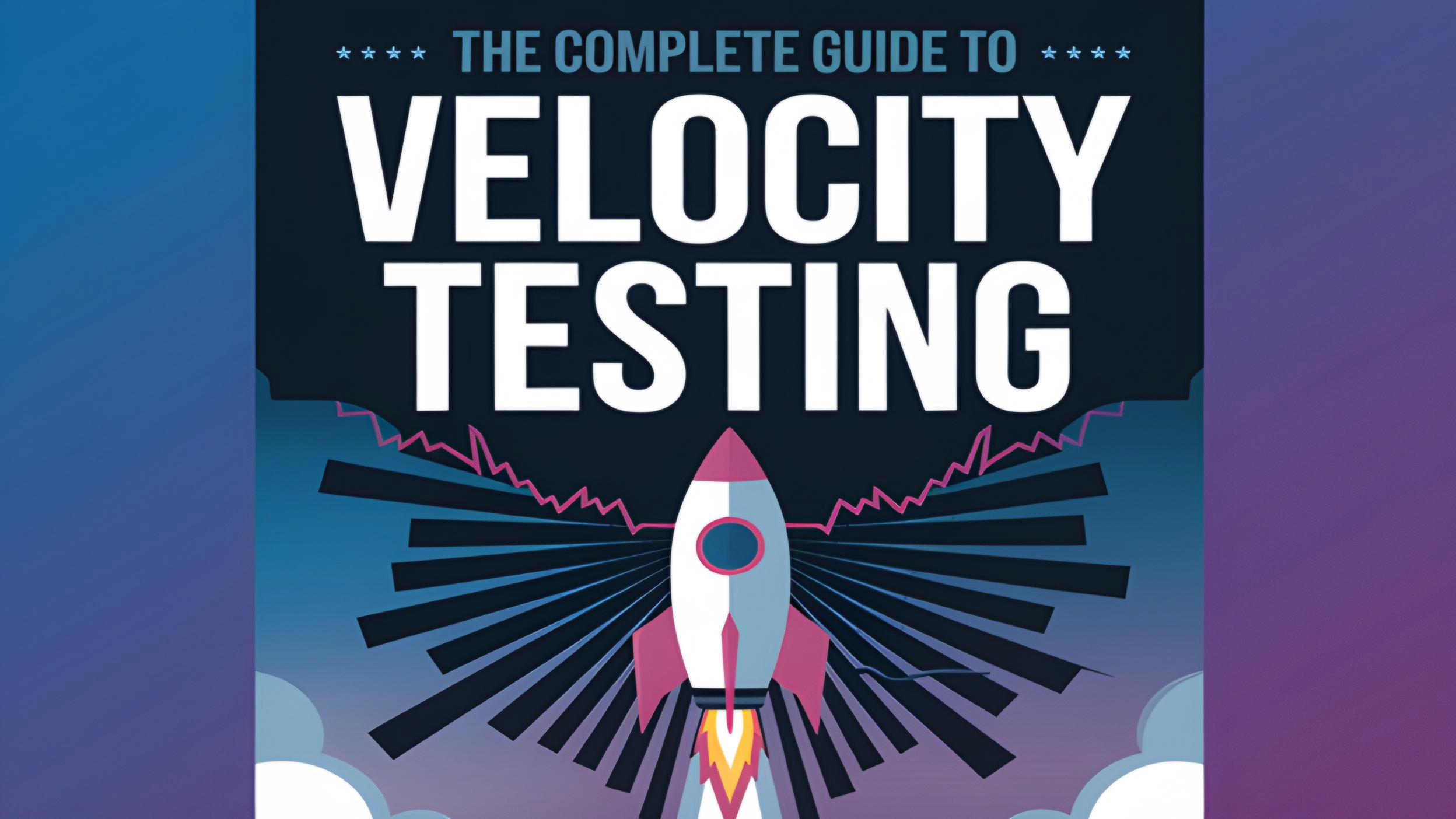The Complete Guide to Velocity Testing: Methods & Best Practices
 Alex Martin
Alex Martin
Velocity testing, also known as testing velocity, ensures that teams can deliver high-quality products rapidly by measuring the speed at which all necessary activities are set up and executed for a project, particularly within an agile framework.
Understanding its methods and best practices is essential for optimizing testing processes and enhancing overall productivity. This comprehensive guide will delve into the importance of velocity testing, its methods and provide actionable strategies to improve it effectively.
History of Velocity Testing
The concept of velocity testing has its roots in traditional software development methodologies, where the focus was on delivering a final product after a long development cycle. However, as the industry shifted towards agile methodologies, the need for faster and more frequent releases became apparent.
Agile development introduced iterative cycles, known as sprints, where small increments of the product are developed and tested. This shift necessitated a more dynamic and responsive testing approach, leading to the evolution of velocity testing.
Today, velocity testing is an integral part of agile development, enabling teams to maintain a high pace of delivery without compromising on quality. It reflects the ongoing evolution of software testing practices aimed at meeting the demands of modern development environments.
What is Velocity Testing?
Velocity testing, also known as speed testing or rapid testing, focuses on assessing how quickly and effectively software can be tested without compromising quality. It emphasizes efficiency and thoroughness in testing to keep up with agile and continuous integration/delivery (CI/CD) practices.
Why is testing velocity important?
Enhances Product Quality: Testing velocity ensures that products are consistently tested throughout the development cycle. This continuous testing helps in identifying bugs and issues early, leading to a higher-quality product. By catching problems early, developers can fix them before they become bigger issues, resulting in a smoother user experience.
Speeds Up Time to Market: In today’s fast-paced market, getting a product to market quickly is crucial. Testing velocity helps teams maintain a fast development pace without sacrificing quality. By integrating testing into the development process, teams can release new features and products faster, giving them a competitive edge.
Reduces Costs: Early detection of defects through high testing velocity can significantly reduce the cost of fixing bugs. The later a bug is found, the more expensive it is to fix. Continuous testing helps catch issues early when they are easier and cheaper to resolve, leading to overall cost savings.
Improves Team Efficiency: It promotes better collaboration among team members. With continuous feedback from testing, developers can quickly address issues and move on to the next task. This streamlined process boosts team efficiency and productivity, leading to more successful projects.
Enhances Customer Satisfaction: A product with fewer bugs and issues leads to happier customers. High testing velocity ensures that the product meets customer expectations by delivering a reliable and well-functioning product. Satisfied customers are more likely to become repeat users and recommend the product to others.
Supports Agile Development: Testing speed is crucial In an Agile development environment. Agile teams use quick cycles and constant feedback to improve their products. High testing speed fits well with Agile methods, helping teams adapt quickly to changes and deliver high-quality software.
Methods to Enhance Velocity Testing
It employs various methods to ensure accurate measurement and analysis of project progress and performance. Understanding these methods can help teams better manage their workflows and improve their overall efficiency. Here are some key methods used are as under:
Leverage Power of GenAI: Everyone knows that GenAI is changing the game in software testing. Leveraging GenAI powered testing tools can definitely improve testing velocity and debugging process. GenAI automation testing platforms such as BotGauge can speed up testing by 10 times and make it more accurate compared to traditional testing methods. BotGauge also helps testers and developers create test scenarios, debug in real-time, and record and replay tests.
Historical Data Analysis: Historical data analysis involves examining past performance data to predict future outcomes. By reviewing completed tasks, teams can identify patterns and set realistic velocity expectations for upcoming sprints. This method relies on accurate and consistent data collection over multiple sprints.
Story Points Estimation: Story points estimation is a popular method where teams assign point values to tasks based on their complexity and effort required. This helps in estimating the amount of work that can be completed in a sprint. By tracking story points completed over time, teams can gauge their velocity and adjust their plans accordingly.
Capacity Planning: Capacity planning involves assessing the available resources and team member availability for a given sprint. By understanding the capacity of the team, project managers can set realistic goals and avoid overloading team members. This method ensures that the team’s velocity aligns with their actual working capacity.
Burn Down Charts: Burn down charts are visual tools that show the amount of work remaining in a sprint versus the time left. These charts help teams track their progress and make necessary adjustments to stay on track. By regularly updating burn down charts, teams can identify potential issues early and maintain a steady velocity.
Continuous Improvement: Continuous improvement focuses on regularly evaluating and refining the team’s processes and practices. Through regular retrospectives and feedback sessions, teams can identify areas for improvement and implement changes to enhance their velocity. This method promotes a culture of learning and adaptability.
Velocity Tracking Tools: Various velocity tracking tools and software are available to help teams monitor their progress and performance. These tools provide real-time data and insights, enabling teams to make informed decisions and stay aligned with their goals. Utilizing such tools can streamline the testing process and improve accuracy.
Speed up Velocity Testing With Your Personal AI Test Agent.
BotGauge is a next-generation AI agent for software testing designed to revolutionize the testing landscape with its groundbreaking capabilities. At the forefront of our innovation is autonomous test case generation and live debugging, making BotGauge an industry leader in this space. It significantly reduces testing costs by 85% and accelerates the testing process, making it 20 times faster than traditional methods.
How to Perform Velocity Testing
Setting Up for Velocity Testing: Covers the preparation steps such as defining objectives, selecting scenarios, and configuring testing environments.
Choosing Metrics: Discusses the key performance indicators (KPIs) or metrics that will be measured during testing, such as response time, throughput, or resource utilization.
Selecting Right Tools: Explains the tools and technologies needed to conduct velocity testing, including both commercial and open-source options suitable for measuring web performance.
Executing Velocity Tests: Details the process of running tests, including setting up test scripts, initiating test runs, and ensuring proper monitoring during testing sessions.
Analyzing Velocity Test Results: Focuses on interpreting the data collected from velocity tests, identifying performance bottlenecks, and drawing actionable insights.
Iterating Based on Velocity Testing Insights: Emphasizes the importance of using test findings to make improvements, adjusting configurations, optimizing code, or scaling resources as necessary.
Common Mistakes and How to Avoid Them
- Pitfalls to Watch Out For:
Over-reliance on manual testing.
Neglecting to update test cases with new features.
Failing to involve testers in the planning phase.
- Solutions and Preventative Measures:
Incorporate automated testing from the start.
Regularly review and update test cases.
Foster a collaborative environment between developers and testers.
Best Practices for Velocity Testing
Here are some best practices to ensure you get accurate and useful results:
Realistic Test Scenarios: Design tests that mirror real-world usage patterns, including various user actions and concurrent users.
Early Integration: Integrate testing early in development to identify and fix performance issues promptly.
Monitor Resource Usage: Analyze CPU, memory, and network usage to optimize system resources during tests.
Automation: Automate testing for consistency and integrate it into CI/CD pipelines.
Establish Baseline Performance: Set baseline metrics for key transactions to measure performance improvements or regressions.
User Interaction Simulation: Simulate user interactions like form submissions to accurately replicate real-world scenarios.
Comprehensive Documentation: Document test scenarios, methodologies, and results to aid understanding and collaboration.
Build Verification Testing (BVT), or Smoke Testing, is a preliminary testing process that validates the stability and functionality of a software build by executing essential test cases. It ensures that the build is stable enough for more in-depth testing, detecting major issues early in the development cycle. BVT is typically automated and integrated into Continuous Integration/Continuous Deployment (CI/CD) pipelines for efficiency. By identifying critical defects early, BVT saves time, reduces costs, and prevents downstream testing delays. Best practices include automating tests, maintaining an updated test suite, and running BVT after every new build.
Curious about how Build Verification Testing can save your team time and ensure software quality? Dive into our detailed guide to discover its importance, best practices, and expert tips to implement it seamlessly. Read more about Build Verification Testing!
Conclusion
Testing velocity is a key part of modern software development, especially in agile methods. It measures how fast and efficiently testing is done without losing quality. By learning and using the best methods, teams can work better, save money, and quickly deliver high-quality products.
Focusing on continuous improvement, clear metrics, and good communication helps teams stay flexible and adapt to changes. This leads to happier customers and a competitive advantage. Using these strategies will help teams improve their testing and succeed in their software projects.
Subscribe to my newsletter
Read articles from Alex Martin directly inside your inbox. Subscribe to the newsletter, and don't miss out.
Written by

Alex Martin
Alex Martin
Passionate about optimizing software testing processes, exploring innovative tools and strategies to improve efficiency and accessibility in testing workflows.